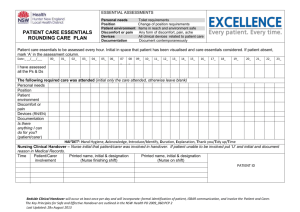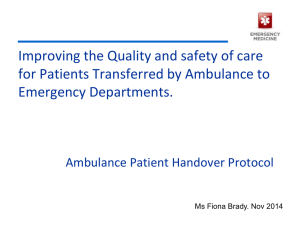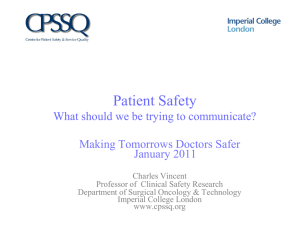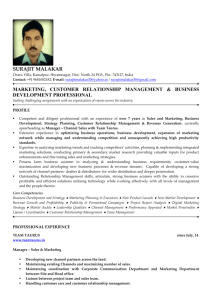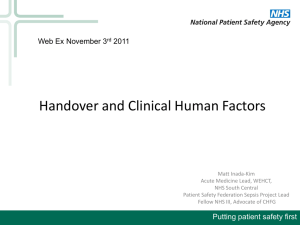Translating Tensions into Safe Practices Through Dynamic
advertisement
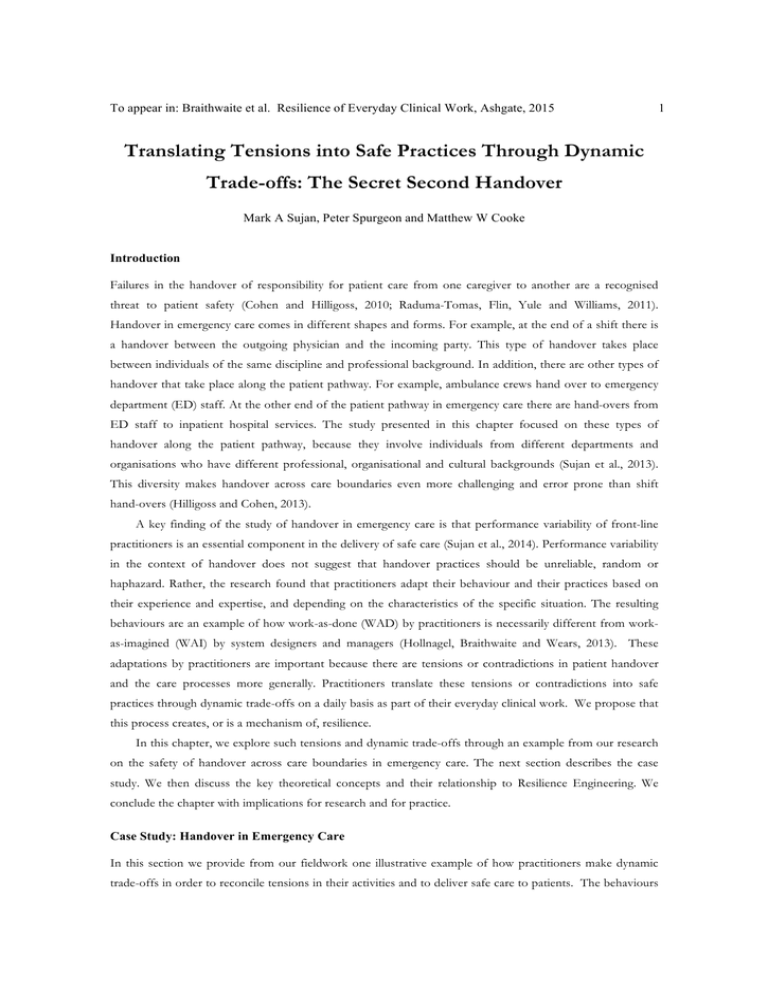
To appear in: Braithwaite et al. Resilience of Everyday Clinical Work, Ashgate, 2015 Translating Tensions into Safe Practices Through Dynamic Trade-offs: The Secret Second Handover Mark A Sujan, Peter Spurgeon and Matthew W Cooke Introduction Failures in the handover of responsibility for patient care from one caregiver to another are a recognised threat to patient safety (Cohen and Hilligoss, 2010; Raduma-Tomas, Flin, Yule and Williams, 2011). Handover in emergency care comes in different shapes and forms. For example, at the end of a shift there is a handover between the outgoing physician and the incoming party. This type of handover takes place between individuals of the same discipline and professional background. In addition, there are other types of handover that take place along the patient pathway. For example, ambulance crews hand over to emergency department (ED) staff. At the other end of the patient pathway in emergency care there are hand-overs from ED staff to inpatient hospital services. The study presented in this chapter focused on these types of handover along the patient pathway, because they involve individuals from different departments and organisations who have different professional, organisational and cultural backgrounds (Sujan et al., 2013). This diversity makes handover across care boundaries even more challenging and error prone than shift hand-overs (Hilligoss and Cohen, 2013). A key finding of the study of handover in emergency care is that performance variability of front-line practitioners is an essential component in the delivery of safe care (Sujan et al., 2014). Performance variability in the context of handover does not suggest that handover practices should be unreliable, random or haphazard. Rather, the research found that practitioners adapt their behaviour and their practices based on their experience and expertise, and depending on the characteristics of the specific situation. The resulting behaviours are an example of how work-as-done (WAD) by practitioners is necessarily different from workas-imagined (WAI) by system designers and managers (Hollnagel, Braithwaite and Wears, 2013). These adaptations by practitioners are important because there are tensions or contradictions in patient handover and the care processes more generally. Practitioners translate these tensions or contradictions into safe practices through dynamic trade-offs on a daily basis as part of their everyday clinical work. We propose that this process creates, or is a mechanism of, resilience. In this chapter, we explore such tensions and dynamic trade-offs through an example from our research on the safety of handover across care boundaries in emergency care. The next section describes the case study. We then discuss the key theoretical concepts and their relationship to Resilience Engineering. We conclude the chapter with implications for research and for practice. Case Study: Handover in Emergency Care In this section we provide from our fieldwork one illustrative example of how practitioners make dynamic trade-offs in order to reconcile tensions in their activities and to deliver safe care to patients. The behaviours 1 To appear in: Braithwaite et al. Resilience of Everyday Clinical Work, Ashgate, 2015 described in the example were observed during the ethnographic field study of handover, and they were then further explored and refined during the semi-structured interviews with a broader range of stakeholders. Emergency Care Handover (ECHO) Project The ECHO project was funded by the National Institute for Health Research (NIHR) Health Services & Delivery Research program (HS&DR). The aims of the project were to explore the risks to patient safety that are associated with failures of handover in the emergency care pathway, and to investigate organizational factors that affect the quality of handover across organizational boundaries and cultures. Research study sites were two English National Health Service (NHS) ambulance services and three English NHS hospitals (the emergency department and the acute medical unit of each hospital). The participating organizations were chosen to reflect a range of characteristics in terms of the population served and the organizational structure. The study was undertaken from April 2011 – December 2012. Research ethics approval was received from South Birmingham Research Ethics Committee (reference 11/WM/0087), and all participating organizations provided institutional approval for the research. The study design was a multidisciplinary qualitative research approach organized into two research streams. Research stream 1 was concerned with the identification and analysis of the risks associated with handover failures in the emergency care pathway. The risk analysis involved nine focus-group based failure mode and effects analysis (FMEA) sessions with purposive convenience samples of staff from the participating organizations. A total of 270 patient handovers were observed and audio-recorded. The recordings were transcribed and analyzed using Conversation Analysis. Research stream 2 aimed to describe common organizational deficiencies that affect handover in the emergency care pathway, and to describe the impact of the organizational model of emergency care delivery. An initial purposive convenience sample of 15 frontline staff participated in semi-structured interviews. Following initial analysis, a second round of semistructured interviews was conducted with a further 24 staff. Interviews were audio-recorded and transcribed. The transcripts were analyzed using Thematic Analysis. Main categories were identified through clustering of codes during meetings of the research team. Categories were constantly compared with the data and revised until new data added no further conceptual insights. The findings were validated with a broader range of stakeholders in a workshop. Handover in the Emergency Care Pathway The British Medical Association defines handover as ‘the transfer of professional responsibility and accountability for some or all aspects of care for a patient, or group of patients, to another person or professional group on a temporary or permanent basis’ (British Medical Association, 2004). This definition emphasizes that handover can include both the transfer of information relevant to patient care as well as the transfer of responsibility for patient care. The emergency care pathway refers to pre-hospital, ED and hospital activities for patients with acute needs. The focus of the research described in this chapter was on handover of patients coming to the 2 To appear in: Braithwaite et al. Resilience of Everyday Clinical Work, Ashgate, 2015 3 emergency department with an ambulance, and patients referred from the ED onwards to acute medicine. Along this pathway several handovers may occur. For critically ill patients requiring immediate treatment, handover occurs from the paramedic to a senior ED doctor in the resuscitation area. Other patients arriving by ambulance will be handed over from the paramedic to the nurse coordinator at the nurses’ station or at a dedicated handover point in the main ED area. When the patient is referred on from the ED there is a handover by phone from the ED doctor to either a doctor or a nurse in acute medicine or a specialty. There is also a handover from the ED nurse to the nurse on acute medicine when the patient is transferred physically onto the ward. The style of communication and the information that is communicated during the handover are dependent on the purpose of the handover and on where in the patient’s journey it occurs. For example, handover from paramedic to ED nurse is predominantly unidirectional and typically includes consideration of aspects such as patient demographics, patient condition, aspects of clinical and social history, treatments given pre-hospital, observation of vital signs, and any symptoms exhibited. When a patient is referred to acute medicine the communication style is more interactive, and the focus of the conversation is on the need and justification for admission (Sujan et al., 2013). The handover from the ED nurse to the nurse on acute medicine will focus on issues relevant to nursing aspects, such as any specific care arrangements that may be required. The Secret Second Handover A specific threat to patient safety is when the ambulances are queuing in the ED, and the ambulance services are losing their ability to respond to emergencies in the community. In order to improve this, targets have been introduced in the NHS in England, which specify the duration of time by which handover needs to have been completed and the ambulances need to be back out on the road. To support achievement of these targets, the process for receiving handover has been redesigned in the ED in one of the organisations that participated in the research. There is now a single dedicated handover between the ambulance crew and the nurse coordinator. The paramedics then take the patient to the assigned cubicle and get back out onto the road. There are good reasons for such a process as it is clear and structured, reduces the time paramedics potentially have to spend waiting for a busy nurse to take handover, and eliminates multiple redundant handovers. This represents an instance of WAI, i.e. of the normative procedures and protocols that practitioners are expected to follow. During the fieldwork, we observed that quite often the WAD differed from the WAI, as the paramedics would hand over a second time to the nurse looking after the patient. Interviews with staff provided further insights into this practice, which was sometimes referred to as the ‘secret second handover’ by practitioners, i.e. as a practice that should not take place according to the official protocols or WAI. Each of the actors involved, paramedics, ED nurse coordinator, and ED nurses, had their own particular perception of this practice. ED nurse coordinators were aware of the second handover, but did not support it. They felt that this practice should be discouraged, because on the one hand it was an unnecessary duplication, and on the other hand the ED would get blamed if the ambulance services were failing to meet the handover targets. To appear in: Braithwaite et al. Resilience of Everyday Clinical Work, Ashgate, 2015 4 This is illustrated in the views expressed by an ED nurse coordinator below, where first the financial impact for the organization (the hospital) is considered when the ambulance service is not meeting the turnaround target, and subsequently the second handover is reflected upon with regard to meeting the target and avoiding duplication. “So what happens obviously because of us trying to reduce the ambulance handover times, so they need to have their…they call it ‘bum on bed’, handover within 15 minutes and then they leave, so in all we took measures of probably about two years ago in order to reduce that, because obviously the financial implications for the Trust [of not meeting the target] […] I think the nurses prefer to get a handover because it saves, you know, they get a bit more of an idea […] but at the same time as a manager, I have the appreciation that we need to get the crews back out on the road as quickly as we can […] so if I see the ambulance service handing over to a nurse, again I do say to them ‘You don’t need to do that. Remember you’ve already handed over to me.’ So, I’m happy to pick them up on that […] because there is no point in handing over to me and my writing it down, unless they are going to do it [get back out on the road].” (ED nurse coordinator) ED cubicle nurses generally were appreciative of receiving a handover from the paramedics following the initial handover to the nurse coordinator. In their view they were taking on responsibility for the patient, and they wanted to ensure that they had all the relevant information that enabled them to provide good quality care to the patient. They felt that the paramedics were best placed to provide important background information that would sometimes not be documented in the notes, or that would otherwise not be brought to their attention easily. This latter aspect is expressed by a staff nurse in the quotation below. “I quite often want to hear from the crew because there’s a lot that they might not have told the sister [ED nurse coordinator], or they’ve told the sister but not gone on the bit of paper and so it’s often their little things then that don’t get put down on there that you miss out on.” (ED staff nurse) Similarly, the paramedics suggested that for them it was a matter of responsibility and accountability. The patient was their responsibility, and they wanted to ensure that everything that they felt was important was actually taken on board by the relevant people in the ED. As a result, in practice paramedics were finding reasons ‘to linger around’ in the ED, completing paper work and other duties, and the cubicle nurses were seeking out the paramedics in order to engineer an opportunity for this secret second handover to take place. The quotation below from an interview with a paramedic provides an illustration of the notion of personal accountability, the view that a verbal handover to the nurse is more suitable to convey subtleties and additional information, and that paramedics use their time in the ED intelligently depending on the needs of the situation. “I just…I think it takes out the human factor, just this piece of paper. I don’t like it. I just…I like to tell the person who’s looking after my patient, because it’s my patient, because I’ve handed over, [tell] them what’s been going on and give them the whole story and give them the opportunity to ask me questions […] we’ve got 15 minutes from when we arrive to when we should hand over […] and then 15 minutes from when we’ve handed over to when we’ve finished our paperwork and we’ve come clear […] so we’ve only got a 30-minute window here […] so I look at it as, OK as long as I press that button I will wait around and talk To appear in: Braithwaite et al. Resilience of Everyday Clinical Work, Ashgate, 2015 5 to the nurse, as long as I’ve cleared in 30 minutes how I spend my time here [is up to the paramedic].” (Paramedic) The analysis of staff interviews identified a number of tensions or contradictions in the organization of the work around handover that may be useful in explaining this evolution of practice. There is a tension in the goals or motivations for handover of the ambulance crews and the ED nurse coordinator. The ambulance crews want to tell the full story, i.e., they want to provide information on everything that they feel is clinically relevant. Ambulance crews, who have seen the patient’s local environment, are often best placed to provide important background information to the ED about the patient’s social and psychological needs (Sujan et al., 2013). The ED nurse coordinator, on the other hand, approaches handover predominantly from a management perspective. For them it is important to determine quickly the acuity of the patient, where they can go in the department, and the implications for the department in terms of workload and availability of resources. Such a management perspective is concerned more with aspects of capacity and patient flow, rather than with clinical details and psychosocial background. Given this tension in goals, it is not altogether surprising that on occasion disturbances in the handover process can be observed. Paramedics, with a more clinical perspective, may feel that the nurse coordinator is not listening properly, and the nurse coordinators, with a management perspective, may perceive that paramedics should get to the point more quickly as the detail is documented in the paperwork. Similarly, there is a tension in the overall goals of the paramedic. They need to ensure the safety of the individual patient under their care. However, they also need to ensure the safety of the patients out in the community. In order to deal with these tensions – different goals and motivations between communication partners, and competing goals for the individual - they adapt their behaviour by making dynamic trade-offs based on their experience and depending on the specific circumstances of the patient in their care. As one paramedic put it, ‘when I am worried I will make sure that I’ll talk to the nurse’. Tensions: Looking at Handover Dialectically The case study presented in this chapter, irrespective of the particular context or setting, provides an illustration of the tensions inherent in the undertaking of a complex task by multiple actors representing different roles, perspectives, priorities and indeed organisations. This is almost inevitable in any such complex, dynamic, interactive process. However, recognising these subtleties is important in how the vulnerabilities of the handover process are understood, how some existing approaches to improvement have been framed, and what type of future recommendations may be appropriate. Studies of handover often approach this activity from an information transfer perspective, where the problem is to ensure the transfer of information from a sender to a more or less passive receiver (Cheung et al., 2010). Accordingly, it is frequently suggested, and attempted in practice, to improve handover in a normative way through the introduction of procedures and standardised, structured communication protocols based on mnemonics such as the popular SBAR (Situation, Background, Assessment, Recommendation) (Haig, Sutton and Whittington, 2006). Reviews of the literature on handover improvement efforts conclude, however, that there is no reliable body of evidence to suggest that these attempts have been To appear in: Braithwaite et al. Resilience of Everyday Clinical Work, Ashgate, 2015 successful (Cohen and Hilligoss, 2010; Talbot and Bleetman, 2007). This echoes cautions that the narrow perspective on information transfer may be potentially impoverishing and limiting (Patterson and Wears, 2010). A complementary approach is to study handover and its tensions dialectically rather than normatively. A useful framework for such a dialectical inquiry may be Activity Theory (Nardi, 1996), which is an approach to studying human behaviour that is rooted in the cultural-historic tradition of Soviet psychology (Vygotsky, 1978). Activity Theory utilises the concept of inner contradictions to explain the development and evolution of practice. Inner contradictions are a misfit or misalignment between different elements of an activity or between different developmental stages of the activity (Kuutti, 1996). They manifest themselves externally as disturbances or disruptions, i.e., as the undesired effects that we perceive. These undesired effects cannot be eliminated without addressing the underlying contradiction. However, the fundamental point of the application of dialectics in this case is that contradictions are the drivers of development. Contradictions are not eliminated - they are encountered in different forms as the activity evolves through its developmental stages. For the research on handover following such a dialectic approach suggests that the tensions that were identified in the example could be interpreted as contradictions that may well be inevitable. As a result, improvements in handover cannot simply aim to eliminate disturbances, such as missed information during handover; neither can they necessarily eliminate the corresponding inner tensions, for example the need to tell the full story conflicting with the need to determine the acuity of the patient and to assess the impact on the department. What this really means is that the inner tensions will drive the shape and form of the handover activity to different levels of development, which in turn may give rise to new tensions and disturbances as their outward manifestations. In the case study described above, the official procedure foresees one handover only between the paramedic and the nurse coordinator. However, in those cases where the paramedic is concerned or feels that there are important details they need to communicate, they may find reasons to stay in the department and thereby create the opportunity for a verbal handover to the cubicle nurse. The paramedic, therefore, adapts to the inner tension in order to resolve it, because it cannot be eliminated. By doing so, new tensions may be created, for example this practice may conflict with the need to get back into the community. Trade-Offs: Creating Safety Through Resilience What we can observe is that practitioners use their experience and skill to make the required adjustments and necessary trade-offs in order to deal with these tensions. In the above example, the introduction of ambulance and ED targets, and the formal procedures and protocols (or WAI) to support achievement of those targets represent a static, a priori trade-off in favour of returning ambulances back to the community as quickly as possible. In this mindset, conducting a second handover appears as a redundant and wasteful practice. Such time-related performance targets aim to ensure that patients get seen within a reasonable amount of time and that the ambulance services are able to respond to emergencies in the community. Meeting targets can act as a powerful motivation and provide corporate 6 To appear in: Braithwaite et al. Resilience of Everyday Clinical Work, Ashgate, 2015 7 focus. Frontline staff often acknowledge the importance of targets, but caution against designing the system around the targets, and they also caution against too many pressures resulting from those targets. One consultant (senior doctor) from the ED describes the potential negative impact on patient care in the quotation below. “That is a problem. We know it is a problem. They [the ambulance service] just say ‘It’s your problem, why are you keeping our paramedics too long.’ It’s not us, it’s them pressing their button and getting out there. So there are issues around timing and there are organizational pressures, which I don’t think you should put too much pressure on, because actually they ensure quality. But the ambulance service is great. They do a superb service but they have managers who are pressing their guys to be back out on the road, back out on the road, back out on the road. Too much pressure inevitably will cause quality of care to drop […] so, organizational pressures to achieve organizational targets […] can impact on the quality of handover and have done. And will continue to do. We guard against that. The paramedics guard against that. But you may have some people in the offices upstairs here or sitting in offices in [the ambulance service] who don’t appreciate our efforts.” (ED consultant) As the ED consultant quoted above suggests, in actual practice practitioners guard against threats to patient care, and they do this by making dynamic trade-offs between the different tensions in order to provide flexibility and resilience to the system, which enables them to deliver safe care to their patients. The paramedic will decide on a case-by-case basis, whether a second handover to the cubicle nurse is required or whether they can safely save time and return to the community. From this perspective, the second handover is not a redundant repetition of a previous handover, but rather an important activity in its own right, with a different purpose, and necessary to ensure the delivery of safe and high-quality care to the patient the paramedics are responsible for. This type of behaviour forms the basis for a different way of thinking about how people create safety in complex socio-technical systems. It denotes a shift from thinking about safety as the avoidance of failure, towards a perception of safety as the creation of success given unpredictable conditions. This is the basic premise of the discipline of Resilience Engineering (Hollnagel, Braithwaite and Wears, 2013). Resilience can be defined as ‘the intrinsic ability of a system to adjust its functioning prior to, during, or following changes and disturbances, so that it can sustain required operations under both expected and unexpected conditions’ (Hollnagel, 2010). A fundamental principle of Resilience Engineering is the assumption that performance variability is the essential feature of individual and collective performance that makes it possible to adjust strategies and activities to changing demands and dynamic situations (Hollnagel, 2009). In this view, there is no fundamental difference between how things go right and how they go wrong – failures happen when the adjustments of an organisation (or team, individual) do not quite match the current conditions, but not because performance is variable in the first place. Conclusion In this chapter we have argued that practitioners need to make dynamic trade-offs in order to translate inevitable tensions in their everyday work into safe practices. This offers an alternative and complementary perspective to the traditional approach that describes clinical systems analytically and normatively. We To appear in: Braithwaite et al. Resilience of Everyday Clinical Work, Ashgate, 2015 8 provided an example from our research on the safety of handover across boundaries in emergency care. The research studied handover dialectically, and has made visible inner tensions within the activity of handover. These inner tensions manifest themselves as disturbances that we perceive as the problems with handover. Practitioners use their experience to adapt their behaviour in order to resolve the tensions, thereby possibly creating new tensions. Failure occurs when the adaptations are insufficient or inappropriate. Improvement efforts aimed at designing out errors and constraining performance variability through the introduction of static procedures, protocols and normative approaches may try to resolve some of these tensions, but there will always be some tensions. As a result, improvement efforts need to consider how the system can provide flexibility and support to practitioners in making the required trade-offs. This should be based on a thorough understanding of everyday clinical work, the tensions that are present, and the resulting evolution of practice. Acknowledgements Pete Chessum, Steve Cross, Larry Fitton, Simon Horniblow, Matthew Inada-Kim and Michelle Rudd were part of the project team. We are grateful to the study participants and their organisations. This project was funded by the National Institute for Health Research Health Services and Delivery Research (NIHR HS&DR) programme (project number 10/1007/26). Visit the HS&DR website for more information. The views and opinions expressed therein are those of the authors and do not necessarily reflect those of the HS&DR programme, NIHR, NHS or the Department of Health. References British Medical Association. (2004). Safe Handover, Safe Patients. Guidance on clinical handover for clinicians and managers. London: BMA. Cheung, D. S., Kelly, J. J., Beach, C., Berkeley, R. P., Bitterman, R. A., Broida, R. I. and White, M. L. (2010). Improving handoffs in the emergency department. Ann Emerg Med, 55(2), 171-180. doi: 10.1016/j.annemergmed.2009.07.016 Cohen, M. D. and Hilligoss, P. B. (2010). The published literature on handoffs in hospitals: deficiencies identified in an extensive review. Qual Saf Health Care, 19(6), 493-497. doi: 10.1136/qshc.2009.033480 Haig, K. M., Sutton, S. and Whittington, J. (2006). SBAR: a shared mental model for improving communication between clinicians. Jt Comm J Qual Patient Saf, 32(3), 167-175. Hilligoss, B. and Cohen, M. D. (2013). The unappreciated challenges of between-unit handoffs: negotiating and coordinating across boundaries. Ann Emerg Med, 61(2), 155-160. doi: 10.1016/j.annemergmed.2012.04.009 Hollnagel, E. (2009). The ETTO Principle: Efficiency-Thoroughness Trade-Off: Ashgate. Hollnagel, E. (2010). Prologue: The Scope of Resilience Engineering. In E. Hollnagel, J. Paries, D. D. Woods and J. Wreathall (Eds.), Resilience Engineering in Practice: A Guidebook: Ashgate. Hollnagel, E., Braithwaite, J. and Wears, R. L. (2013). Resilient Health Care. Farnham: Ashgate. To appear in: Braithwaite et al. Resilience of Everyday Clinical Work, Ashgate, 2015 9 Kuutti, K. (1996). Activity Theory as a Potential Framework for Human-Computer Interaction. In B. A. Nardi (Ed.), Context and Consciousness. Cambridge, MA: MIT Press. Nardi, B.A. (1996). Context and Consciousness. Cambridge, MA: MIT Press. Patterson, E. S. and Wears, R. L. (2010). Patient handoffs: standardized and reliable measurement tools remain elusive. Jt Comm J Qual Patient Saf, 36(2), 52-61. Raduma-Tomas, M. A., Flin, R., Yule, S. and Williams, D. (2011). Doctors’ hand-overs in hospitals: a literature review. BMJ Qual Saf, 20(2), 128-133. doi: 10.1136/bmjqs.2009.034389 Sujan, M., Chessum, P., Rudd, M., Fitton, L., Inada-Kim, M., Spurgeon, P. and Cooke, M. W. (2013). Emergency Care Handover (ECHO study) across care boundaries: the need for joint decision making and consideration of psychosocial history. Emergency Medicine Journal. doi: 10.1136/emermed-2013202977 Sujan, M., Spurgeon, P., Inada-Kim, M., Rudd, M., Fitton, L., Horniblow, S. and Cooke, M. (2014). Clinical Handover Within The Emergency Care Pathway And The Potential Risks Of Clinical Handover Failure (ECHO). NIHR Journals Library. Talbot, R. and Bleetman, A. (2007). Retention of information by emergency department staff at ambulance handover: do standardised approaches work? 10.1136/emj.2006.045906 Vygotsky, L. S. (1978). Mind in Society: Harvard University Press. Emerg Med J, 24(8), 539-542. doi:


